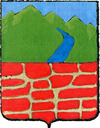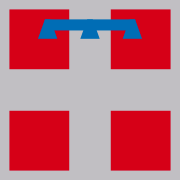Pieve Vergonte
| Pieve Vergonte | ||
|---|---|---|
| Comune | ||
| Pieve Vergonte | ||
| ||
 Pieve Vergonte Location of Pieve Vergonte in Italy | ||
| Coordinates: 46°00′16″N 8°16′06″E / 46.0045402°N 8.268456°ECoordinates: 46°00′16″N 8°16′06″E / 46.0045402°N 8.268456°E | ||
| Country | Italy | |
| Region | Piedmont | |
| Province | Verbano-Cusio-Ossola (VB) | |
| Frazioni | Fomarco, Rumianca, Megolo Cima, Megolo Mezzo, Megolo Fondo[1] | |
| Government | ||
| • Mayor | Maria Grazia Medali[2] | |
| Area[1] | ||
| • Total | 41.67 km2 (16.09 sq mi) | |
| Elevation[1] | 232 m (761 ft) | |
| Population (31 December 2015)[1] | ||
| • Total | 2,593 | |
| • Density | 62/km2 (160/sq mi) | |
| Demonym(s) | Pievesi[1] | |
| Time zone | UTC+1 (CET) | |
| • Summer (DST) | UTC+2 (CEST) | |
| Postal code | 28886 | |
| Dialing code | 0324 | |
| Patron saint | St. Vincent and St. Atanasius[1] | |
| Saint day | 22 January[1] | |
| Website | Official website | |
Pieve Vergonte is a comune (municipality) in the Province of Verbano-Cusio-Ossola in the Piedmont region of Italy. It is about 20 kilometres (12 mi) northwest of Verbania and 110 kilometres (68 mi) northeast of Turin.
Geography
Pieve Vergonte lies in the valley of Ossola where the Anza river flows into the Toce. It is bordered, west to east, by the municipalities of Piedimulera, Vogogna, Premosello-Chiovenda, and Anzola d'Ossola.[3] It is about 20 kilometres (12 mi) northwest of Verbania and 110 kilometres (68 mi) northeast of Turin.
The town is served by State Highway 33 from Simplon.[4]
Main sights
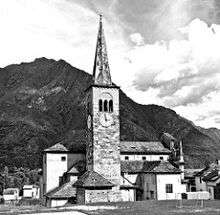
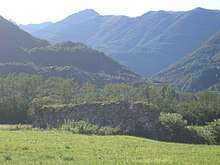
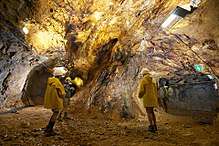
- The Church of Pieve Vergonte
- The Workers' Village, designed by architect Paolo Vietti-Violi from Vogogna, is, with the one of Villadossola, among the model villages for northern workers built during the years of Benito Mussolini's government (1922–1943).[5]
- The Chemical Factory, with offices designed by Vietti-Violi
- The cinema designed by Vietti-Violi[6]
- The mill for grinding gold ore, of which only the tub remains, at the Park of the Fallen of the Great War
- Borgaccio Wall, near the river Toce, which demarcates Pieve Vergonte from the nearby village of Vogogna. It is the remains of a wall of the castle of Pietra Santa, which was destroyed on 9 February 1348, and it is commonly called the Borgaccio.
Economy
Industry
The industrial chemical plant of Pieve Vergonte was founded in 1915 on the initiative of the Italian Society of Explosive Products (PETS) based in Milan, with capital of 2,500,000 lire. The first production for military purposes was the production of iodine monochloride of chlorobenzene and phosgene used during the First World War and later in the African campaign.
During World War II, Clorosoda, sulfuric acid, and fertilizers were produced. After the war, shutting down the production of sulphuric acid, Rumianca SpA, and then the SIR Group, developed new product lines for the production of DDT and chloroaromatics. These products were used by the United States of America during the Vietnam War.
In 1981, the facilities of this company were transferred to the ENI Group and the ANIC Company. The ANIC, then EniChem, DDT plants ran until June 1996, and remaining in production until their sale on 1 July 1997 to Tessenderlo, Italy. The clorosoda, chlorine and aromatic synthetic HCL are in production for the Tessenderlo Group.
In May 2013, Tessenderlo Group sold Tessenderlo Partecipazioni SpA, and its subsidiary Tessenderlo Italy Srl, to International Chemical Investors Group (ICIG).[7] The transaction includes the plant in Pieve Vergonte (VB), where there now are an active electrolysis plant, one for chloro-aromatics, and two hydroelectric plants that provide energy. Tessenderlo Italy employs a total of 113 people. Achim Riemann, Managing Director of ICIG, said: "The integration upstream of Tessenderlo Italy, with direct supply of energy through its hydroelectric plants, is vital for the competitiveness of the plant of Pieve Vergonte and so we want to maintain this integration and have both hydroelectric concessions renewed for the long term." The company trades under the name of hydrochemitalia.[8]
Energy production
The village of Pieve Vergonte produces electricity from hydroelectric power. The largest producer is the Edison Company with plants in Val Anzasca and Pieve Vergonte, both fed by the waters of the river Anza with a total average production of 95 GWh. The second-largest producer is Tessenderlo's Battiggio plant, ex-Rumianca of Ceppo Morelli in Val Anzasca, on the Toce river at Megolo, which has a total average production of 90 GWh.
Natural resources and minerals
Along the creek Marmazza, above the village of Pieve Vergonte, in the Toppa Valley, mining is of great value. There are many pyrite minerals scattered throughout the Ossola valley, which can not be easily mined, and which are entirely neglected. Gold-bearing pyrites were first detected in the quarries of the Maffiola brothers in the valley.
The extraction of gold from the mines of the Toppa Valley was done with mercury, a process first developed by the Spaniard Pedro Fernandez de Velasco in the Americas and thence introduced to Europe by Baron De Born, where an amalgamation was obtained with of fire, and which was used in all the gold mines in Ossola.[9]
The gold production of the Val Toppa mining company, which was listed on the London Stock Exchange in 1863, valued in British pounds/shillings/pence:[10]
- 1864 – Production 509 oz (14.43 kg) & .275 – £1798/18/9 (566,560 Euros in Jan 2017)
- 1865 – Production 574 oz (16.28 kg) & .575 – £2032/14/5 (638,911 Euros in Jan 2017)
- 1866 – Production 1400 oz (39.69 kg) & .925 – £4957/15/8 (1,558,320 Euros in Jan 2017)
with an average production of 1 ounce "oz" and 5 pennyweight "dwt" of gold per tonne of ore mined.
References
- 1 2 3 4 5 6 7 "Il Comune in Breve" [The Municipality in Brief]. Comune di Pieve Vergonte (in Italian). Retrieved 14 February 2018.
- ↑ "Sindaco" [Mayor]. Comune di Pieve Vergonte (in Italian). Retrieved 14 February 2018.
- ↑ "Come Raggiungerci" [How to reach us]. Comune di Pieve Vergonte (in Italian). Retrieved 23 February 2018.
- ↑ "Home". Comune di Pieve Vergonte (in Italian). Retrieved 23 February 2018.
- ↑ (Simon Martin, 2004, p.81)
- ↑ (Canella, Giuntini, 2009, p.280)
- ↑ "Who We Are". International Chemical Investors Group. Retrieved 19 February 2018.
- ↑ "Benvenuti nel sito internet di HydroChem Italia - Pieve Vergonte" [Welcome to the Website of HydroChem Italia - Pieve Vergonte]. HydroChem Italia (in Italian). Retrieved 19 February 2018.
- ↑ Rosina 1819.
- ↑ "XE Currency Converter". XE.com. Retrieved 19 February 2018.
Sources
- De Bartolomeis, G. Luigi (1843). Notizie topografiche e statistiche sugli stati sardi: dedicate A.S.S.R.M Carlo Alberto [Topographical Data and Statistics on Sardinian States: dedicated to His Majesty Charles Albert] (in Italian). Turin: Chirio e Mina. Retrieved 28 February 2018.
- Casalis, Goffredo (1847). Dizionario geografico, storico, statistico, commerciale degli stati di S.M. il re di Sardegna [Geographical, historical, statistical, commercial dictionary of the states of H.M. the king of Sardinia] (in Italian). 16. Turin: Presso G. Maspero Librajo. p. 652. Retrieved 21 February 2018.
- Diacono, Paolo (1990). Pin, Italo, ed. Storia dei Longobardi [History of the Lombards]. Biblioteca di storia (in Italian). Pordenone: Studio Tesi. ISBN 978-887692231-2. Retrieved 7 April 2018.
- Jenkinson, Charles (1785). A collection of all the treaties of peace, alliance, and commerce between Great Britain and other Powers, from the treaty signed at Munster in 1648 to the treaties signed at Paris in 1783. II – from 1713 to 1748. London, opposite Burlington House, Piccadilly: J. Debrett. Retrieved 19 February 2018.
- Labus, Giovanni (1842). Antica romana via del Sempione: nuovamente osservata e illustrata; con monumenti contemporanei [The Ancient Roman Road from Simplon: newly observed and illustrated; with contemporary monuments] (in Italian). Milan: I. R. Istituto lombardo. Retrieved 19 February 2018.
- Martin, Simon (2004). Football and Fascism: The National Game Under Mussolini. New York, USA: Berg Publishers. ISBN 978-185973705-7. Retrieved 24 April 2018.
- Robolini, Giuseppe (1826). Notizie appartenenti alla storia della sua patria: raccolte ed illustrate da Giuseppe Robolini, gentiluomo pavese [News belonging to the history of his homeland: collected and illustrated by Giuseppe Robolini, a gentleman from Pavia] (in Italian). II. Pavia: Fusi e Comp. Retrieved 24 February 2018.
- Rosina, Gaetano (1819). Osservazioni e richerche minearologiche-chimiche sopra alcune valli dell'ossola del chimico Gaetano Rosina: coll'aggiunta di un metodo economico per estrarre l'oro da una miniera di quei dintorni riputata finora incoltivabile [Observations and mineralological-chemical researches in some valleys of the Ossola by the chemist Gaetano Rosina: with an economic method for extracting gold from a mine whose surroundings have been rebuilt and is now unworkable] (in Italian). Milan: Giovanni Pirotta. Retrieved 19 February 2018.
- Soldani, Massimiliano (1999). L'ultimo poeta armato: Alessandro Pavolini segretario del Partito fascista repubblicano [The last armed poet: Alessandro Pavolini, secretary of the Republican Fascist Party]. Sinergie (in Italian). Milan: Barbarossa. OCLC 43082470. Retrieved 7 April 2018.
- Viganò, Marino (1991). Il Ministero degli Affari Esteri e le Relazioni Internazionali della Repubblica Sociale Italiana: 1943–1945 [The Ministry of Foreign Affairs and International Relations of the Italian Social Republic: 1943-1945] (in Italian). Milan: Jaca Book. ISBN 978-881695081-8. Retrieved 24 March 2018.
- De Vit, Vincenzo (1859). Memorie Storiche di Borgomanero e del suo mandamento compilate dal Sacerdote Vincenzo De Vit [Memories of Borgomanero and his mandate: compiled by Father Vincenzo De Vit] (in Italian). Milan: Ditta Boniardi Pogliani di Ermenegildo Besozzi. Retrieved 24 April 2018.
- Memorie del Reale istituto lombardo di scienze, lettere ed arti, Volume 1,- Milano – Tipografia Bernardoni – 1843
| Wikimedia Commons has media related to Pieve Vergonte. |
